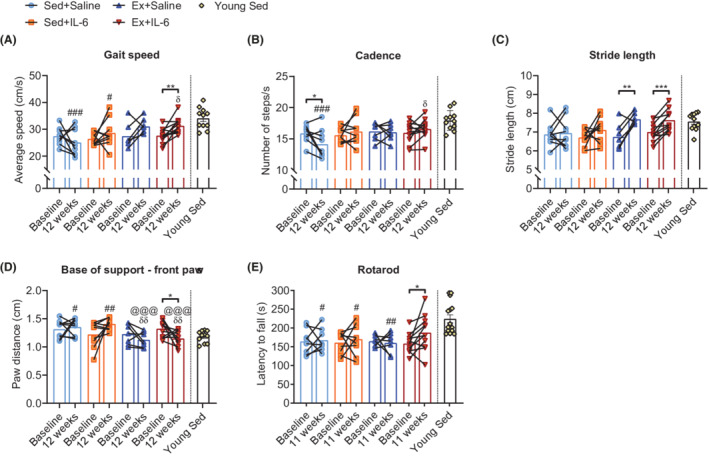Figure 5.

rIL‐6 treatment improves gait and motor coordination in endurance‐trained mice. (A–E) Parameters of quantitative gait analysis at baseline and after 12 weeks of the intervention in old groups and in an independent cohort of young sedentary mice: (A) average body speed (cm/s), (B) cadence (number of steps/s), (C) average stride length (in cm) of hindlimbs and forelimbs, and (D) base of support, that is, distance (cm) between paws of forelimbs (Sed+Saline, n = 9; Sed+IL‐6, n = 9; Ex+Saline, n = 7; Ex+IL‐6, n = 11; and young Sed, n = 11). (E) Motor coordination assessed with an accelerated rotarod test at baseline and in the 11th week of the intervention in old groups and in young sedentary mice (Sed+Saline, n = 8; Sed+IL‐6, n = 9; Ex+Saline, n = 7; Ex+IL‐6, n = 11; and young Sed, n = 14). Data are presented as mean and individual paired values connected with a black line and mean ± SEM including individual values (Young Sed group in A–E). Paired Student's t‐test and one‐way ANOVA followed by Sidak's multiple comparisons between retests of old groups and young sedentary group. *P < 0.05, **P < 0.01, and ***P < 0.001 as indicated. # P < 0.05, ## P < 0.01, and ### P < 0.001 old groups vs. young Sed group. @@@ P < 0.001 Sed+Saline vs. Ex+Saline or Ex+IL‐6; δδ P < 0.01 Sed+IL‐6 vs. Ex+Saline or Ex+IL‐6.
